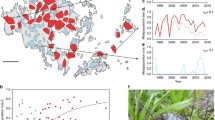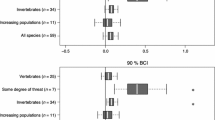Abstract
Both island-biogeographic (dynamic) and niche-based (static) metapopulation models make predictions about the distribution and abundance of species assemblages. We tested the utility of these models concerning such predictions for terrestrial vascular plants using data from 74 landscapes across the globe. We examined correlations between species frequency and local abundance and shapes of the species frequency distribution. No data set met all of the predictions of any single island-biogeographic metapopulation model. In contrast, all data sets met the predictions of the niche-based model. We conclude that in predicting the distribution of species assemblages of plants over scales greater than 10–1 km, niche-based models are robust while current metapopulation models are insufficient. We discuss limitations in the assumptions of the various models and the types of empirical observations that they will each have to deal with in further developments.
Similar content being viewed by others
References
Brown, J.H. (1984) On the relationship between abundance and distribution of species. Am. Nat. 124, 255–279.
Brown, J.H. (1995) Macroecology. University of Chicago Press, Chicago, IL.
Campbell, B.M. and Moll, E.J. (1977) The forest communities of Table Mountain, South Africa. Vegetatio 34, 105–115.
Collins, S.L. and Glenn, S.M. (1990) A hierarchical analysis of species' abundance patterns in grassland vegetation. Am. Nat. 135, 633–648.
Collins, S.L. and Glenn, S.M. (1991) Importance of spatial and temporal dynamics in species regional abundance and distribution. Ecology 72, 654–664.
Diamond, J.M. (1984) ‘Normal’ extinctions of isolated populations. In Extinctions (M.H. Nitecki, ed.), pp. 191–246. University of Chicago Press, Chicago, IL.
Ellison, A.M. (1993) Exploratory data analysis and graphic display. In Design and Analysis of Ecological Experiments (S.M. Scheiner and J. Gurevitch, eds), pp. 14–45. Chapman and Hall, New York.
Gaston, K.J. and Lawton, J.H. (1989) Insect herbivores on bracken do not support the core-satellite hypothesis. Am. Nat. 134, 761–777.
Gaston, K.J. and Lawton, J.H. (1990) Effects of scale and habitat on the relationship between regional distribution and local abundance. Oikos 58, 329–335.
Gerdol, R., Ferrari, C. and Piccoli, F. (1985) Correlation between soil characteristics and forest types: A study in multiple discriminant analysis. Vegetatio 60, 49–56.
Gilpin, M. and Hanski, I. (eds) (1991) Metapopulation Dynamics: Empirical and Theoretical Investigations. Academic Press, London.
Gotelli, N.J. (1991) Metapopulation models: The rescue effect, the propagule rain, and the core-satellite hypothesis. Am. Nat. 138, 768–776.
Gotelli, N.J. (1995) A Primer of Ecology. Sinauer Associates, Sunderland, MA.
Gotelli, N.J. and Kelley, W.G. (1993) A general model of metapopulation dynamics. Oikos 68, 36–44.
Gotelli, N.J. and Simberloff, D. (1987) The distribution and abundance of tallgrass prairie plants: A test of the core-satellite hypothesis. Am. Nat. 130, 18–35.
Hall, J.B. and Swaine, M.D. (1981) Distribution and Ecology of Vascular Plants in a Tropical Rainforest: Forest Vegetation in Ghana. Junk, The Hague.
Hanski, I. (1982) Dynamics of regional distribution: The core and satellite hypothesis. Oikos 38, 210–221.
Hanski, I. (1991) Reply to Nee, Gregory and May. Oikos 62, 88–89.
Hanski, I. and Gyllenberg, M. (1993) Two general metapopulation models and the core-satellite species hypothesis. Am. Nat. 142, 17–41.
Hanski, I., Kouki, J. and Halkka, A. (1993) Three explanations of the positive relationship between distribution and abundance of species. In Species Diversity in Ecological Communities (R.E. Ricklefs and D. Schluter, eds), pp. 108–116. University of Chicago Press, Chicago, IL.
Hartigan, J.A. and Hartigan, P.M. (1985) The dip test of unimodality. Ann. Stat. 13, 70–84.
Hartigan, P.M. (1985) Computation of the dip statistic to test for unimodality. Appl. Stat. 34, 320–325.
Hastings, A. (1991) Structured models of metapopulation dynamics. Biol. J. Linn. Soc. 42, 57–71.
Hastings, A. and Harrison, S. (1994) Metapopulation dynamics and genetics. Ann. Rev. Ecol. Syst. 25, 167–188.
Levin, S.A. (1992) The problem of pattern and scale in ecology. Ecology 73, 1943–1967.
Levins, R. (1969) Some demographic and genetic consequences of environmental heterogeneity for biological control. Bull. Entomol. Soc. Am. 15, 237–240.
MacArthur, R.H. and Wilson, E.O. (1967) The Theory of Island Biogeography. Princeton University Press, Princeton, NJ.
Muc, M. (1976) Ecology and primary production of high arctic sedge-moss meadows, Devon Island, NWT, Canada. PhD dissertation, University of Edmonton, Alberta.
Nee, S., Gregory, R.D. and May, R.M. (1991) Core satellite species: Theory and artefacts. Oikos 62, 83–87.
Rabinowitz, D., Cairns, S. and Dillon, T. (1986) Seven forms of rarity and their frequency in the flora of the British Isles. In Conservation Biology: The Science of Scarcity and Diversity (M.E. Soulé, ed.), pp. 182–205. Sinauer Associates, Sunderland, MA.
Scheiner, S.M. (1992) Measuring pattern diversity. Ecology 73, 1860–1867.
Scheiner, S.M. and Rey-Benayas, J.M. (1994) Global plant diversity: Patterns and processes. Evol. Ecol. 8, 331–347.
Schoener, T.W. and Spiller, D.A. (1992) Is extinction rate related to temporal variability in population size? An empirical answer for orb spiders. Am. Nat. 139, 1176–1207.
Simberloff, D.S. and Wilson, E.O. (1970) Experimental zoogeography of islands: A two-year record of colonization. Ecology 51, 934–937.
Tokeshi, M. (1992) Dynamics of distribution in animal communities: Theory and analysis. Res. Pop. Ecol. 34, 249–273.
Wilkinson, L. (1988) SYSTAT: The System for Statistics. SYSTAT, Evanston, IL.
Wright, D.H. (1991) Correlations between incidence and abundance are expected by chance. J. Biogeogr. 18, 463–466.
Author information
Authors and Affiliations
Rights and permissions
About this article
Cite this article
Scheiner, S.M., Rey-Benayas, J.M. Placing empirical limits on metapopulation models for terrestrial plants. Evolutionary Ecology 11, 275–288 (1997). https://doi.org/10.1023/A:1018464319460
Issue Date:
DOI: https://doi.org/10.1023/A:1018464319460




